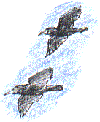
|
JackdawsThursday, 26th June 2003, page 1 of 2, West Yorkshire |
![]()
![]()
![]()
![]() Rocks | History |
Workshop |
Links | Home
Page
Rocks | History |
Workshop |
Links | Home
Page
![]()
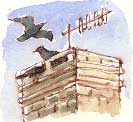 Four
jackdaws fly over a Victorian stone-built terrace at
Horbury Bridge. Two perch on a chimney that has had the chimney pots removed.
There's a concrete paving slab on top with letterbox-sized vents around
the sides for ventilation. Just about the ideal nest site for a jackdaw
and perhaps it is: first one, then the next, of what is evidently a pair,
pops into one of the slots, while a third bird watches from the television
aerial.
Four
jackdaws fly over a Victorian stone-built terrace at
Horbury Bridge. Two perch on a chimney that has had the chimney pots removed.
There's a concrete paving slab on top with letterbox-sized vents around
the sides for ventilation. Just about the ideal nest site for a jackdaw
and perhaps it is: first one, then the next, of what is evidently a pair,
pops into one of the slots, while a third bird watches from the television
aerial.
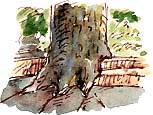 The
Spreading Chestnut Tree
The
Spreading Chestnut Tree
The cracks in the driveway behind my Mum's house - a Victorians woollen mill owner's villa - are beginning to reach the corner of the house and the drains.
The old horse chestnut is now like a much-loved house plant that has got too big for its pot. But we can't pot it on. Chestnuts aren't as invasive as willows or cherries in their root systems but, as a general rule, the tree expert who's taking a look at the problem tells us, the roots of a mature tree extend a little beyond the leaf canopy. The tree now engulfs the stone steps at the edge of the lawn.
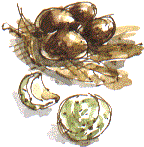 The
surface of the driveway, which I remember years ago as fairly level, now
heaves up towards the trunk. We've got a choice: apart from the cracks
in the drive the tree is doing no real damage so far so we could leave
it until it proves to be a problem, or we could have it taken down now
and replace it with something smaller - a silver birch perhaps.
The
surface of the driveway, which I remember years ago as fairly level, now
heaves up towards the trunk. We've got a choice: apart from the cracks
in the drive the tree is doing no real damage so far so we could leave
it until it proves to be a problem, or we could have it taken down now
and replace it with something smaller - a silver birch perhaps.
My Mum would like to resurface the drive but there doesn't seem to be much point in doing that as things are. I guess this chestnuts days are numbered but I can't help thinking of the tree that inspired Tolkien's story Leaf by Niggle:
' . . . a great-limbed poplar tree that I could see even when lying in bed. It was suddenly lopped and mutilated by its owner, I do not know why. It is cut down now, a less barbarous punishment for any crimes it may have been accused of, such as being large and alive. I do not think it had any friends, or any mourners, except myself and a pair of owls.'
If it was me, I'd give the chestnut a few more years, but it's not my decision.
Horse chestnuts are a part of local history. A carriage drive was planted with 108 them in Clarence Park, Wakefield, in the Victorian period and the Duke of Clarence himself (the highest-ranking suspect in Jack the Ripper theories) planted a white horse chestnut there in 1891 (for more see my booklet on Thornes Park).
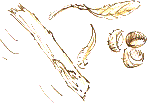 The
tree man tells us that unfortunately he has had to cut down a number of
large, mature, healthy horse chestnuts which were growing in front gardens.
So many children (and I've seen adults do it too) throw objects up into
the trees to dislodge the unripe conkers that the house owners were worried
that they'd be liable if something was to fall on a passer-by on the pavement.
The
tree man tells us that unfortunately he has had to cut down a number of
large, mature, healthy horse chestnuts which were growing in front gardens.
So many children (and I've seen adults do it too) throw objects up into
the trees to dislodge the unripe conkers that the house owners were worried
that they'd be liable if something was to fall on a passer-by on the pavement.
Ants' Subway
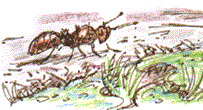
![]() As
I'm working on the paths by the veg beds I roll back the end of some of
the weed-suppressing fabric. A tunnel, about the diameter of a ballpoint
pen runs under the fabric, beneath the path. At a glance you'd think it
was a groove left by a large root. When I roll back the next bit of fabric
between the next two veg beds there's another, no doubt a continuation
of the same routeway.
As
I'm working on the paths by the veg beds I roll back the end of some of
the weed-suppressing fabric. A tunnel, about the diameter of a ballpoint
pen runs under the fabric, beneath the path. At a glance you'd think it
was a groove left by a large root. When I roll back the next bit of fabric
between the next two veg beds there's another, no doubt a continuation
of the same routeway.
These particular ants are small and appear black, or almost black. When you think of their size of the and the hardness of the compacted earth beneath the path, this is an impressive engineering project.
Escargots Alfresco
 I've
heard from Liv (I've changed names to protect the innocent here for reasons
which will become apparent) who lives southwest of Limerick in Ireland.
On Tuesday she saw, and managed to film for a few seconds, a hummingbird
hawkmoth which was feeding on mint flowers in her garden. It's
the first record I've heard of for this migrant from the continent this
year. As we've already seen several painted lady butterflies
(another migrant species) here in England I shall start looking out for
this species.
I've
heard from Liv (I've changed names to protect the innocent here for reasons
which will become apparent) who lives southwest of Limerick in Ireland.
On Tuesday she saw, and managed to film for a few seconds, a hummingbird
hawkmoth which was feeding on mint flowers in her garden. It's
the first record I've heard of for this migrant from the continent this
year. As we've already seen several painted lady butterflies
(another migrant species) here in England I shall start looking out for
this species.
We get to discussing gardens and the subject of slugs and snails comes up. Liv tells me:
Hummingbird Hawkmoth Records
That sounds like my youngest kid. He took my steamer out into the garden one evening when he was about 2 years old. I went to check on him after a few minutes and he told me he was cooking dinner. He lifted the lid and showed me several big luscious slugs that he had gathered. I noticed that he had something in his mouth too and managed to pry his mouth open .... he told me 'IT' was a jelly sweet! So much for escargot in salad! My husband is Italian and I'm Irish so I am assuming that it was his foreign genes that gave him a taste for 'escargots' as I would never have the idea of putting them into my mouth. I'm even reluctant to walk through our long grass now in my sandals. Anyway, it didn't do him any harm, in fact he hasn't needed any antibiotics in the last 2 years ..... Did you know that in Italy they have a homeopathic cough syrup which contains 'snail/slug extracts'? It is
believed that it helps to loosen mucous in cases where you have a bad cough and a lot of phlegm. I can't say that I have ever wanted to try it but maybe it works.

![]() Next page |
Previous page | This
day in 2000 | This month |
Nature Diary |
Home
Page
Next page |
Previous page | This
day in 2000 | This month |
Nature Diary |
Home
Page
![]()